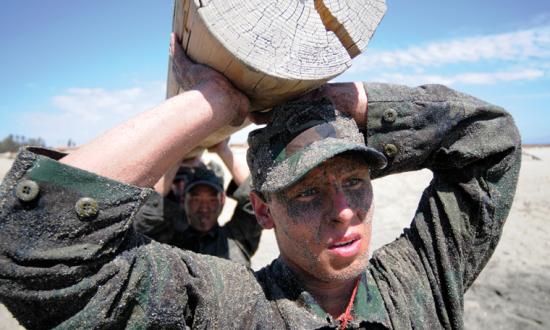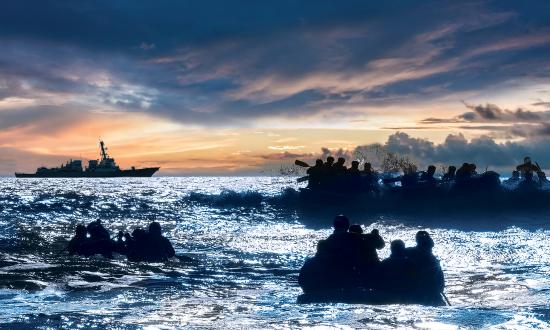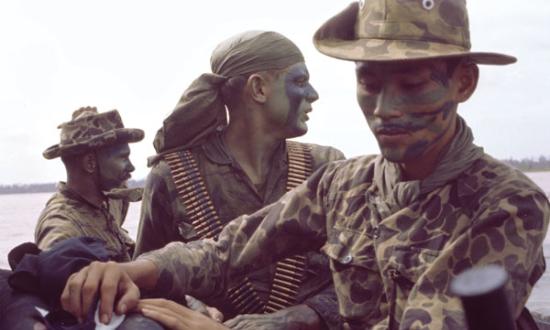Across the spectrum of warfare, the United States and its allies face new challenges. Authoritarian states conduct irregular statecraft and operations in the gray zone between peace and war, aiming to coerce nation-states, normalize government and private market corruption, and subvert the international rules-based order. Adversaries including China, Russia, North Korea, and Iran challenge individual freedoms, fundamental human rights, and the security of the global commons. They leverage technology to erode U.S. margins of advantage. These threats demand U.S. special operations forces evolve quickly and creatively.
While the past two decades of combat shifted Naval Special Warfare’s (NSW’s) principal missions to counter–violent extremist organizations (C-VEO) and counterterrorism (CT), we never left our “frogman” roots. Today, we are applying hard-earned combat lessons—identifying irregular opportunities; fusing operations and intelligence; planning missions; and rehearsing and integrating with the joint force, other agencies, the intelligence community, and reliable international partners—to expand deterrence options and decision space. With new and energized partnerships with U.S. Space, Strategic, and Cyber Commands, we are creating innovative capabilities and concepts to increase diplomatic leverage; influence adversary leaders to undercut their confidence in success; deliver war-winning access in conflict; and mitigate the political, strategic, and military risks the nation must assume to deter its adversaries.
To create leverage and scalable options, Naval Special Warfare is developing “red button” options that can hold adversaries and their critical military capabilities at risk. These initiatives are anchored in a renewed emphasis on undersea and seabed warfare.
Sensing, Problem Solving, And Adapting For Relevance
In March 2021, Naval Special Warfare Force Master Chief Bill King and I conducted undersea clandestine infiltration training on board a Virginia-class submarine—something I had not done since I was an ensign at SEAL Team Eight out of the escape trunk of a Sturgeon-class submarine. We were there to experience firsthand the warfighting competence, complexities, risks, and capabilities of these distinctive operations and identify ways to increase options in today’s complex, contested operational environment.
A principal responsibility of leaders is to understand what has changed—and then boldly, fearlessly lead their organizations to adapt. This requires knowledge of one’s own force, capabilities, strengths, and weaknesses. It also requires seeing the threats and opportunities. With that perspective, leaders must create a vision to meet the threats and opportunities and align their team with it. This is what our frogman forefathers taught us, and their spirit remains deep within Naval Special Warfare’s culture and ethos. It is what makes our transformation possible.
Core to Naval Special Warfare’s ongoing transformation are our high standards, humility, grit, problem-solving and relentless pursuit of excellence. The nation trusts its frogmen to be ready for complex, risky missions. To meet those expectations, we must identify, enroll, assess, select, train, and develop the people who will ensure future mission success.
During World War II, U.S. naval commandos—called underwater demolition teams (UDTs) at the time—pioneered special operations missions from the sea. These were irregular warfare missions from the maritime flanks of the enemy. Over the beach, into the littoral, against island targets, and deep into riverways, these teams operated in complex threat and environmental conditions. Their resolute examples inspire how Naval Special Warfare today is evolving to fight under, on, and above the sea to extend the reach of the joint force into denied areas for intelligence collection and high-leverage, efficient, and effective actions.
Naval Special Warfare’s organizational transformation and modernization priorities are to:
• Strengthen the rigor and precision of candidate identification, assessment, selection, enrollment, training, and development, with bold force design changes to maintain our relevance
• Experiment with new warfare concepts and operate with joint partners to make step changes in integrated deterrence across all domains
• Build comparative combat advantage through artificial intelligence (AI) and machine learning (ML)
Personnel Changes: Better Assessment, Selection, And Development
New approaches to recruitment, assessment, selection, and training are underpinning our transformation. Recognizing our community suffered several high-profile cases of lapses in judgment and leadership over the past few years, we are putting increased emphasis on individual character, cognitive and leadership assessment, and development. In 2021, we formed a new Echelon IV command—Naval Special Warfare Assessment Command—that will employ active-duty SEALs and special warfare combatant crewmen (SWCCs) to identify, engage, and enroll future candidates. This command will provide a more precise initial assessment of candidates and continually evolve assessment approaches across the continuum of NSW careers. With the establishment of this command, Naval Special Warfare no longer will rely on traditional recruiting methods to find future SEALs and SWCCs. We are identifying and engaging potential candidates from demographics that historically have not thought about joining our team. These efforts will give us an edge in leader selection and candid feedback for self-improvement and individual development.
Over this same period—with Navy Education and Training Command’s support—we disestablished the separate recruit rifle division at boot camp in December 2020. SEAL and SWCC recruit candidates are now fully integrated with the rest of their Navy shipmates in recruit training. This means SEAL and SWCC candidates solve their first problems in the Navy together with teammates from the greater Navy. At the same time, we are implementing new efforts to enroll diverse candidates in Naval Special Warfare. And we moved the Naval Special Warfare preparatory school from Great Lakes to Coronado to concentrate our assessment and selection cadre, so they can conduct the same level of preassessment scrutiny already applied to officer candidates to enlisted candidates before their final approval to begin basic underwater demolition/SEAL (BUD/S) and basic crewman training.
Unit 1 rigs her Mk 25 underwater breathing apparatus before a dive. NSW is partnering with the Marine Corps to develop complementary concepts, expeditionary sustainment, and staging for inside-force operations in contested environments. Credit: U.S. Navy (Alex Perlman)
These initiatives involved learning from other services’ assessment and selection programs, private-sector best practices, and innovative ideas from the fleet, bottom up. The new leadership assessment and selection program improves selection precision for all officer and senior enlisted milestone assignments at all echelons. We now conduct a four-day assessment—modeled after the Army’s new Battalion Commander Assessment Program (BCAP) and Special Operations Forces’ Special Mission Unit best practices—that includes robust cognitive and noncognitive psychometric testing, written assessments, peer and subordinate evaluations, and double-blind candidate interviews that mitigate cognitive biases in leader selection.1
Tactical Changes
Naval Special Warfare is implementing changes across its tactical formations for survivability, lethality, and relevance within joint warfighting concepts. At the core tactical maneuver-element level, we reduced the number of SEAL platoons from 72 to 48 over the past year—realigning end strength into the remaining platoons. These newer, bigger platoons now have a third subordinate maneuver element for organic cyber, electronic warfare, and multidomain unmanned system capabilities. Having fewer platoons also reduced the risk of leadership failure that had increased as Naval Special Warfare grew to meet C-VEO demands after 9/11. The platoon reduction resulted in a 33 percent increase in tactical leadership selectivity.
Special operations command-and-control (C2) concepts have been redesigned to address the operational risk for complex 21st-century missions. Innovations in this area center on a flag-level task force that will take our type-command functions of manning, training, and equipping and combine them with new operational authorities to oversee strategic maritime missions and hold our adversary systems at risk.
We merged Naval Special Warfare Group 3 and Group 10, two O-6 Echelon III major commands, into Naval Special Warfare Group 8 which fuses undersea capabilities (including SEAL delivery vehicle [SDV] teams) and advanced intelligence, cyber, electronic warfare, and multidomain unmanned systems within the special reconnaissance teams. This shift provides task force depth across joint warfighting functions, unity of command, and new irregular capabilities to counter peer adversary systems.
Experimentation, Concept Development, And Partners
Early in my career, I deployed on Navy aircraft carriers, and I still have vivid memories of living directly under the “three-wire” (the primary arresting wire for aircraft returning to the flight deck) as a junior SEAL on board the USS John F. Kennedy (CV-67), Saratoga (CV-60), and Kitty Hawk (CV-63). On six-month deployments, we directly supported the carrier air wing, extending the Navy’s options during the Balkan conflict and later in Southeast Asia. Such past experiences with fleet integration are driving current advances in maritime reconnaissance and scouting; strike, mine, undersea, and seabed warfare; strategic sabotage against critical infrastructure; and deception. These concepts increase survivability and lethality of the joint force with kinetic, electronic warfare, and cyber effects. Wargaming and testing the survivability, lethality, and relevance of new concepts illuminates capability gaps and refines support to “big Navy’s” distributed maritime operations.
Rear Admiral Wayne E. Meyer, the “father” of the AEGIS combat system, exhorted his teams to “build a little, test a little, learn a lot.” In that vein, we are working with the Navy’s submarine force and Marine expeditionary forces to develop new tactics, techniques, and procedures. Naval Special Warfare has long enjoyed a special relationship with the submarine force. Distinct stealthy NSW capabilities, combined with advanced stealthy submarines, create an unrivaled asymmetric advantage. Last summer, SEALs and SDVs conducted interoperability exercises in the eastern Mediterranean on board a Virginia-class submarine for a proof-of-concept with the U.S. Sixth Fleet, affirming the ability to adapt together for new strategic, multidomain options that expand national leverage. We also are partnering with the Marine Corps on complementary concepts, expeditionary sustainment, and staging for inside force operations in contested battlespace.
As Naval Special Warfare continues to fulfill our enduring C-VEO and CT missions to protect the homeland from external attack, we are pushing to test, evaluate, experiment, and integrate scalable effects against critical adversary systems (including C5ISRT) of great power rivals. We are learning how to integrate our capabilities to complement the F-35 Lightning II, littoral combat ships, Zumwalt-class destroyers, Military Sealift Command assets, and Navy unmanned vehicles. Operating alongside these manned and unmanned platforms, we are testing new concepts, technologies, and tactics; contributing to the Navy’s unmanned task force mission; and amplifying the lethality, scalability, access, and precision of Navy combat power.
Recently, the commander of U.S. Special Operations Command decided to hold approximately a third of Naval Special Warfare’s combat-ready force in reserve for experimentation, concept development, and high-return deploy-for-purpose (DfP) missions. This is a significant change from the past two decades of deploying all our combat-ready forces. These DfP reserve elements increase our agility to respond to crises around the globe and—perhaps most critical—provide combat-ready forces to experiment and generate new concepts at lower training risk after they have mastered core mission-essential tasks. Allowing combat-ready forces to experiment with new tactics, techniques, and procedures for the most stressing hard targets and environmental conditions is helping answer the Navy’s and joint force’s key operational problems. These combat-ready forces train against peer-level opposition forces that replicate advanced detection capabilities in exercises using objective evaluators. Naval Special Warfare’s DfP elements already are advancing readiness in extreme threat and environmental conditions, such as the Arctic’s High North, where we see an increase in destabilizing activities in the maritime commons.
Allies And Partners
As adversaries press for advantage across domains, U.S. military forces must integrate with allies and reliable partners to strengthen our collective power to uphold the rules-based international order. As Defense Secretary Lloyd Austin wrote in May 2021, we plan to use our “existing capabilities, build new ones, and use all of them in new and networked ways—shoulder-to-shoulder with our allies and partners.”2 NSW forces participate in military-to-military contact events around the globe. In 2021, we trained with Japanese, South Korean, Australian, and Indian counterparts in the Indo-Pacific theater and with Croatia, Germany, Hungary, Romania, Cyprus, and Greece in the European theater. Opportunities to train, learn, and operate new technologies and share data for common intelligence and domain awareness result in integrated capabilities to deter those who would threaten freedom.
Innovate To Win
Naval Special Warfare possesses a range of unique capabilities for close access missions. Our top priority reflects that of the Department of the Navy—developing concepts and capabilities that bolster deterrence and expand U.S. warfighting advantage against China.3 Competing against advanced threats demands constantly updating and adapting new technology. The challenges ahead require multidomain autonomous unmanned systems and scalable, compounding technologies that impose costs on the adversary and create deescalation opportunities in crises.
Naval Special Warfare is investing in resilient networks and modernizing enterprise software, security, and data infrastructure to advance AI/ML applications. With existing data on human performance, machines, and adversaries, and applying recent DoD policies for digital advantage, we are applying AI to human warfighting readiness, corporate efficiencies, and intelligence, maneuver, protection, and fires—to create advantage. We are experimenting with autonomous marsupial concepts—things in and on things that do things—that leverage interoperable multidomain robots. We are pursuing collaborative, intelligent, networked, autonomous, and interoperable unmanned systems for decision dominance, access, precision, and scale, while thoughtfully contributing to DoD efforts to set policies and precedents to address the inherent moral, legal, and ethical risks in disruptive technologies. AI depends on experimenting with algorithms, and we see opportunities within our small but agile force to serve as a test bed for new technology for DoD and the Fleet. Experimenting with NSW’s small force first means the Navy can accept more risk while transferring new technologies to larger systems and forces faster.
Distinctive Options—From And On The Sea
In the quest to innovate for military advantage and edge, Naval Special Warfare is prioritizing the distinctive missions that only we can do—under, on, and above the sea and into the littorals. Our most recent combat experiences brought us farther on land than past generations of naval commandos, but our maritime roots will chart the course for the next era. Naval Special Warfare is innovating to solve the hardest security challenges—by building a disciplined, precise, and lethal force.
1. Lolita Baldor, “Navy SEALs to Shift from Counterterrorism to Global Threats,” The Associated Press, 21 April 2021.
2. Lloyd Austin, “The Pentagon Must Prepare for a Much Bigger Theater of War,” Washington Post, 5 May 2021.
3. Carlos Del Toro, One Navy-Marine Corps Team: Strategic Guidance from the Secretary of the Navy, Department of the Navy, October 2021.











